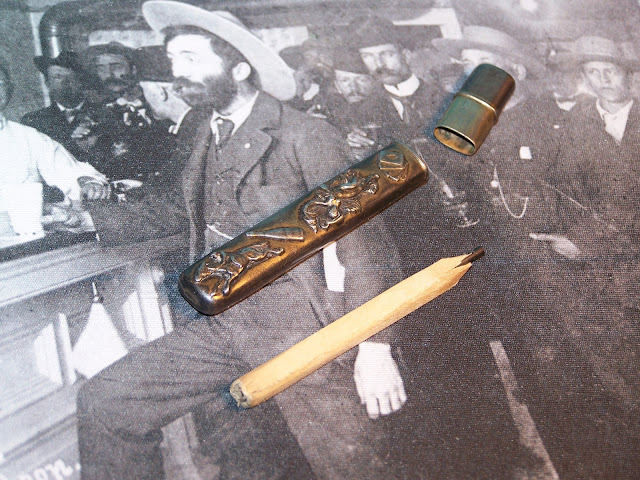 |
| "No one is a victim until he marks the con man as his victim." |
age 64 of Alias Soapy Smith I provide a perfect example of the bunco man manipulating the greed of his victim. It comes from an article published in 1879. Yesterday, 133-years later, I received the identical swindle via email. The more things change, the more they stay the same.
The swindle from 1879 reads as follows.
A new swindle is reported as being perpetrated by “artful dodgers” in Pennsylvania…. They send a letter written in the familiar tone of an old acquaintance, reminding the recipient that when he left their boarding house he owed a little bill of, possibly, $2. He is further informed that they can readily sell the jewelry which, among other things, he left behind in a satchel, for $20 or $30. If he will remit the $2 they will send him the satchel and contents. The gullible one knows well … he never possessed such property, nor boarded in such a place, but he is willing to quietly obtain some other person’s valuable jewelry, and therefore sends the $2. He receives nothing. This swindle is based solely upon the idea that a large percentage of people are by nature dishonest enough to take that to which they have not the slightest just claim, if they have the chance. People … beaten by the trick are served precisely right. There is not the slightest danger that they will put officers of the law upon the track of the swindlers. Shame will keep them from exposing their own crooked intentions.
The con is that the greedy dupe will send in the $2 (the equivalent of $67.14 today) to obtain another persons valuable property. Below is the swindle I received yesterday that utilizes the same concept. I have to wonder how the sender learned of it?
McCARRAN INTERNATIONAL AIRPORT
Las Vegas, Nevada
Airport Shuttle Keeper
Good Day,
Sorry for the delay in this message, On Friday we were checking over some files and packages in the office and we discover an ATM CARD which was address on your name, Home address and email (I think it is a winning funds) I believe you can remember a dealing that has to do with some cooperate body or individual about this said funds to be deliver to you through an (ATM CARD) but I do not have idea why it was on hold at our Airport up-to-date.
So we contacted the Authorities and they asked us to get in contact with Senator Harry Reid, to get an approval to figure out what was in the package, After checking over the ATM CARD, we discover a total sum of $10,000,000.00 ($10 Million USD) through the router figurative machine who check on balance through the number on a ATM CARD, so we report back to the Senator Harry Reid and we were asked to deliver the package to you from this office. (Senator Harry Reid, Lloyd D. George Building, 333 Las Vegas Boulevard South, Suite 8016)
We need you to reconfirm your full name and Home address if show as it is on the package we have here.
If you want it to be delivered to you immediately, it will cost you just $450 which is the charges for the insurance certificate and delivery of the ATM CARD meanwhile your funds is save with our securities service so please have that in mind.
Below is the payment information, payment should be made via money gram or western union and also send us your address as well for the delivery so that it won’t be deliver to the wrong address and someone else will receive a miracle he or she never worked so hard for to get.
NAME: VAUGHN ALSTON
ADDRESS: LAS VEGAS
STATE: NEVADA
COUNTRY: U.S.A
AMOUNT: $450
The information above is where the ATM CARD was stop at McCARRAN INTERNATIONAL AIRPORT in Las Vegas, Nevada.
THIS MAIL IS NOT A SPAM OR SCAM MESSAGE, WE CAN DELIVER YOUR FUNDS TOMORROW IF WE RECEIVED REPLY FROM YOU, I HAVE INCLUDED MY NAME AND MY SSN FOR YOU TO KNOW I AM FOR REAL AND NOT A SCAM IF YOU NEED TO VERIFY ME, SO STOP DEALING WITH ANY BODY IF YOU HAVE SOME SCAMMER YOU ARE DEALING WITH AND FOCUS ON GETTING YOUR FUNDS HERE IN THE STATES, YOU HAVE BEEN WARNED NOT TO DISCLOSE THIS DEAL TO NO ONE OR ELSE TERMINATION FROM THE HOUSE OF SENATE WILL PENETRATE ON YOUR FUNDS DUE TO THE FACT THAT YOU WERE TRYING TO CONTACT ANOTHER PERSON TO FIND OUT WHAT THIS IS, SO NO MISTAKE OF SUCH WILL BE TOLERATED.
CHARLES SWIDER
Supervisor Manager
MY SSN NUMBER: 016-38-1497
fakeairportshuttllekeeperemail@mail.com
For: Airport Shuttle Keeper
Note the grammar errors as well as the ever present message that "this mail is not a spam or scam message." It has to be real because he gave you his social security number right? More than once I have seen a signature name that nearly gives the con away, such as Swinder, so close to Swindler.
"Smith may be a grafter, but he is one of the most generous, kind-hearted men I ever met in my life. He is always ready to help those in distress and he loves his family. To know Smith is to like him."
—Sylvester Scovel,
New York World reporter, 1897.



































